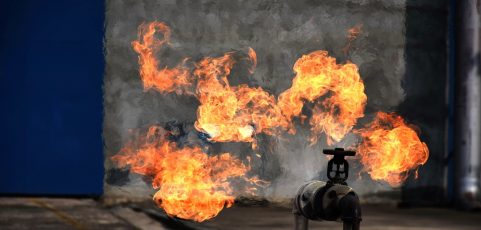Which Toxic Gas Is Commonly Produced by Fire
CO is potentially present whenever combustion occurs. The two most important fire ground toxic gases that utilize this pathway are carbon monoxide CO and hydrogen cyanide HCN commonly known in the fire service as The Toxic Twins.

Buyer S Guide To Flueless Gas Fires Direct Fireplaces
In the oil and gas industry petroleum gases are often referred to as sweet gas or hydrocarbon gas.

. Carbon monoxide CO and Lower Explosive Limit LEL detectors are commonly used by fire investigators but fires in modern structures can cause the release of many other toxic gasses as well. What is the vapor density of air. Produce such gases were the primary articles burning in only 5 of the fires reported 9.
Carbon Monoxide CO Carbon monoxide is a colorless odorless and highly toxic gas that is produced as a by-product of incomplete combustion. During a fire depending upon the FR system used may increase yields of common toxic fire gases such as carbon monoxide and hydrogen cyanide and introduce additional toxic products such as acid gases. Phosgene reacts with water to form hydrochloric acid and carbon dioxide.
The batteries which are found in billions of consumer devices like smartphones and tablets were found to leak more than 100 toxic gases including carbon monoxide. The differences between LC 50 and COSHH 15 min toxic assessments in these fires show that the relative importance of the four toxic gases for death are different from that of impairment of escape. 06-02indd 15 1162007 85753 AM.
This is a great question and one that a literature review from the UKs Health Safety Laboratory in 2008 tried to answer. Fires may release corrosive or toxic environmental contaminants such as to a building interior or to the wider exterior environment. Toxic gases and particles typically released during building fires where they come.
Toxic gas measurements show that numerous toxic species are generated during fire and mainly acid gases. Can Hydrogen Spontaneously Combust. It eliminates the bloods ability to deliver oxygen throughout the body.
Which state must a fuel be in for combustion to take place. The predominant toxic gas is carbon monoxide which is readily generated from the combustion of wood and other cellulosic materials. At concentrations above 40000 ppm four percent it may cause a fire or explosion.
Carbon monoxide bonds to the hemoglobin molecules in red blood cells preventing them from properly transporting oxygen. Some commonly accepted notions concerning fire hazards are questioned. Hydrogen cyanide results from the burning of plastics such as PVC pipe and interferes with cellular respiration.
What is the process called when a material decomposes upon being exposed. During a fire these additives do not evolve toxic gases. The Real Killer Among Fire Gases.
Dioxide a very toxic and strong smelling gas that can cause irritation and death. From nitrogen oxides and organic irritants eg aldehydes can be formed in fires. CO works as an asphyxiant by binding hemoglobin 200 times more effectively than oxygen.
Lithium-ion batteries can produce dozens of dangerous gases when overheated according to a new study from the Institute of NBC Defence and Tsinghua University in China. Although most investigators agree that carbon monoxide is the major hazard in gas inhalation there is less agreement as to the role of other toxic gases and smoke. Both inorganic irritants eg halogen acids and those formed.
While the total amount of those products is not so important their low toxic thresholds impose to consider them for the toxic impact evaluation. The major lethal factors in uncontrolled fires are toxic gases heat and oxygen deficiency. Irritant effects produced from exposure.
For these plywood fires CO dominates in relation to death and for impairment of escape the other three gases are more important and each plywood had. Toxic gases have a broad range of uses including agricultural fertilizer production pure sulfur production water purification chemical reduction oxidizing. 6-16SECTION 6 Characteristics of Materials and Products.
The Chameleon Fire Investigator Safety kit detects eight toxic gasses that can be found at a site during fire overhaul fire investigation and other post-fire operations. 14 rows Table 1. Hydrogen catches fire as a gas or liquid at low temperatures which makes it flammable as opposed to combustible.
Phosgene is a highly toxic gas produced by the burning of chlorinated hydrocarbons or the action of ultraviolet radiation on such compounds. The Top 5 Deadly Gases in the Oil and Gas Industry. Petroleum gases and vapors consist of harmful toxins like benzene butane and methane.
The role of smoke in fire situations requires further study as does that of carbon monoxide heat and other toxic gases. Smoke that is present during a structure fire is composed of several irritating toxic and asphyxiant chemicals depending on the materials that. Which toxic gas is commonly produced by fire.
The most common carbon monoxide CO can be deadly even in small quantities as it replaced oxygen in the bloodstream. The TCPP content of RPUF foam was reduced and fire-retardant PU with lower toxicity was producedCoated zinc borate and the combinations of the fire-retardants were successful in producing non-toxic fire-retardant and smoke suppressant PU foam. These synthetic materials are made of carbon hydrogen and nitrogen atoms and when they are decomposed in a fire they produce hydrogen cyanide HCN a very toxic gas plus CO and other combustion products.
Which Gas Supports In Burning Fire Quora


0 Response to "Which Toxic Gas Is Commonly Produced by Fire"
Post a Comment